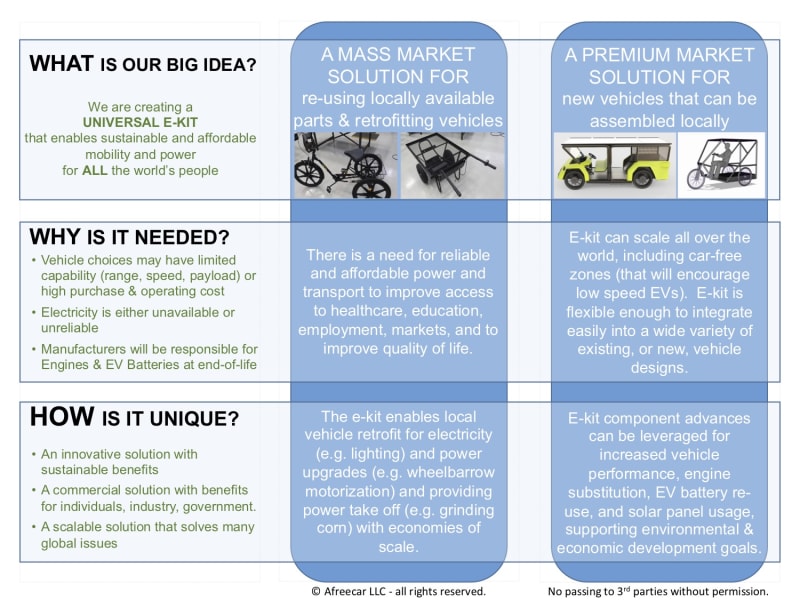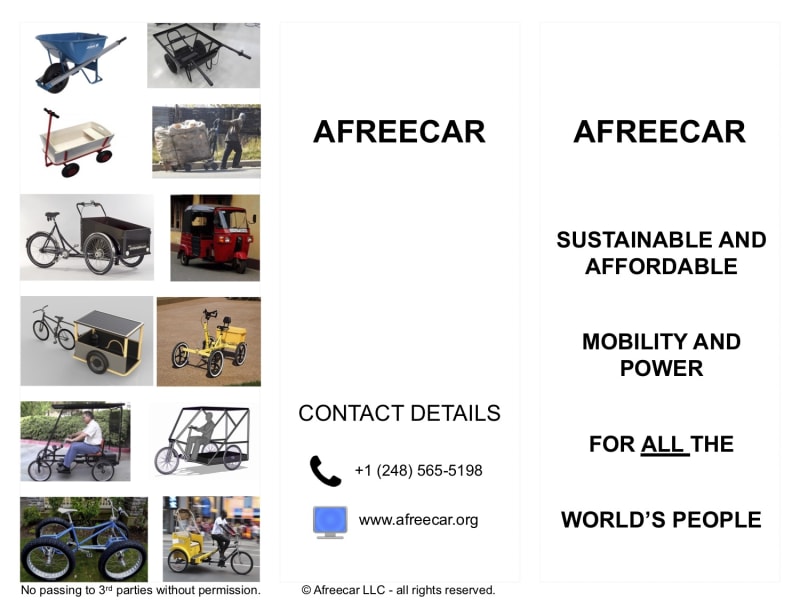Mobility and power enable improved quality of life and economic development but current rural vehicle and power solutions in the developing world have either very limited utility or are too expensive to be broadly deployed. Part of the problem is that traditional vehicles (whether motorized or non-motorized) can only be used for transport and this limits their utility and productivity. Another challenge is that the cost to import a complete vehicle is high and creates no local manufacturing capability whereas there may not be the expertise to build one from scratch and the end-product may not have the required cost, quality, reliability and durability.
Our proposed business idea addresses both issues. Instead of building vehicles from scratch or importing vehicles, we plan to retrofit existing low speed vehicles (e.g. providing power assist to a wheelbarrow, substituting the internal combustion engine on a 3-wheeled tuk-tuk, etc.) with a solar e-kit. Since much of the vehicle cost has already been paid for, the addition of an e-kit will be much less expensive than building or importing a complete vehicle; the e-kit effectively enables low cost improvement with a step function increase in utility because it not only allows customers to have better transport (faster, safely climbing and descending hills, carrying more, longer range) but also provides them with electric power (lighting, chilling, cellphone charging, etc.) and mechanical power (water pump, corn grinding, welding, etc.).
This increased utility creates much more profit potential for the owner as it can improve productivity by leveraging synergies between electricity and transport. Examples can include charging cellphones while on the move, transporting crops in a refrigerated vessel to reduce spoilage, attaching a corn grinder to the vehicle so that it can be both transported and milled by the same person, eliminating the middleman, and so on.
A common solar e-kit that can accommodate many types of vehicles will increase economies of scale and, therefore, reduce cost and increase quality and reliability at the same time. This is critical because the local partner (e.g. a vehicle assembler or even the end user) may have familiarity with mechanical systems (e.g. brakes, frames, wheels, tires, etc.) and knows how to find replacement parts or fix them but they are unlikely to have had much experience dealing with solar e-kit components such as solar panels, batteries, electric motors and electronics.
Therefore, the solar e-kit benefits from being made at scale with high quality and reliability, while simultaneously being designed to make local vehicle integration straightforward.
Our novel intellectual property is to create a mechanical, electrical and software coupling that enables a universal solar e-kit to be integrated across different types of vehicles. The initial focus is low speed vehicles such as providing power assist to non-motorized vehicles (wheelbarrow, ox cart, tricycle, etc.) and to substitute internal combustion engines on lower speed motorized vehicles (motorbikes, tuk-tuks, etc.).
Like this entry?
-
About the Entrant
- Name:Christopher Borroni Bird
- Type of entry:teamTeam members:Chris Borroni-Bird
Rich Saad - Software used for this entry:Altair software tools
- Patent status:pending





